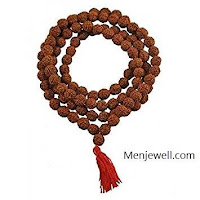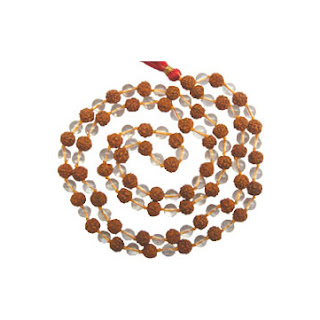Rudraksha History
This article
is about the rudraksha (or rudraksh) seed.For the
principal source of the seeds, see Elaeocarpus ganitrus Rudraksha, also
rudraksh, Sanskrit: rudrākṣa,
is a seed traditionally used for prayer beads in Hinduism. The seed is produced
by several species of large evergreen broad-leaved tree in the genus
Elaeocarpus, with Elaeocarpus ganitrus being the principal species. Rudrakshas
are primarily used in India and Nepal as beads for organic jewellery and mala
and are valued similar to semi-precious stones. As such, they are also the
source of superstitious claims similar to beliefs related to magnetic or
crystal bracelets, faith healing and other medical pseudoscience.
Etymology
Rudraksha is a
Sanskrit compound consisting of the name Rudra ("Shiva") and akṣa
("Teardrops")
Benefits
Rudraksha beads are
believed to provide good support for those who are constantly on the move and
who eat and sleep in a variety of places. This is because they are claimed to
create a cocoon made of the wearer's own energy. It is said that if the situation
around one is not conducive to one's kind of energy, one will experience
difficulty settling down. Sadhus or sannyasis living in the forest would have
to resort to naturally available water sources. A common belief was that, if a
Rudraksha were held above the water on a string, it would turn clockwise if the
water was good and drinkable. If it was unfit for consumption, it would go
counter-clockwise.
Definition
and meaning of the word Rudraksha
·
Aksha means "Teardrops".
Rudra and aksha together mean "the one that is capable of looking at and
doing everything" (for example, the third eye). Aksha also means
"axis". Since the eye can rotate on one axis, it too is known as
"aksha".
·
Rudra is one of Shiva's Vedic names. A
(अ) means to
receive and ksha (क्ष)
means to give. Hence, aksha (अक्ष)
denotes the ability to receive or give. Rudraksha is the one that has the
ability to wipe our tears and provide happiness.
Rudraksha
Tree:
Creation of the
rudraksha tree from the tears of deepest meditation shed by Rudra (Shiva) upon
seeing the unrighteous conduct of demon Tarakasur's sons, and their destruction
by Shiva. found from sea level up to 3000m above. The Rudraksha tree grows in a
narrow space, not on open ground. Its leaves resemble those of tamarind or nux
vomica, but are longer. It yields one to two thousand fruits annually. The
Yatis (Ascetics) in the Himalayas survive only on these fruits. These fruits
are also known as amritphala (Fruits of Nectar). They satisfy thirst.
Rudraksha
Fruit
Spiritual
use
A common type has
five divisions, and these are considered to be symbolic of the five faces of
Shiva. It should only be worn on a black or red string/thread or, rarely, a
gold chain. Rudraksha malas have been used by Hindus as rosaries from at least
the 10th century for meditation purposes and to sanctify the mind, body and
soul.






Comments
Post a Comment